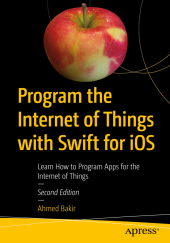 Neuerscheinungen 2018Stand: 2020-02-01 |
Schnellsuche
ISBN/Stichwort/Autor
|
Herderstraße 10
10625 Berlin
Tel.: 030 315 714 16
Fax 030 315 714 14
info@buchspektrum.de |

Ahmed Bakir, Gheorghe Chesler, Manny de la Torriente
(Beteiligte)
Program the Internet of Things with Swift for iOS
Learn How to Program Apps for the Internet of Things
2. Aufl. 2018. xviii, 455 S. 192 SW-Abb. 254 mm
Verlag/Jahr: SPRINGER, BERLIN; APRESS 2018
ISBN: 1-484-23512-6 (1484235126)
Neue ISBN: 978-1-484-23512-6 (9781484235126)
Preis und Lieferzeit: Bitte klicken
Learn how to build apps using Apple´s native APIs for the Internet of Things, including the Apple Watch, HomeKit, and Apple Pay. You´ll also see how to interface with popular third-party hardware such as the Raspberry Pi, Arduino, and the FitBit family of devices. Program the Internet of Things with Swift and iOS is an update to the previous version and includes all new Swift 4 code. This book is a detailed tutorial that provides a detailed "how" and "why" for each topic, explaining Apple-specific design patterns as they come up and pulling lessons from other popular apps. To help you getting up and running quickly, each chapter is framed within a working project, allowing you to use the sample code directly in your apps.
The Internet of Things is not limited to Apple devices alone, so this book also explains how to interface with popular third-party hardware devices, such as the Fitbit and Raspberry Pi, and generic interfaces, like Restful API´s and HTTPS. You´ll also review new API´s like Face ID and new design considerations, and look more closely at SSL and how to make IoT connected apps more resistant to hackers. The coverage of Apple Watch has been expanded as well. The Internet of Things is waiting - be a part of it!
What You´ll Learn
Use Apple´s native IoT Frameworks, such as HealthKit, HomeKit, and FaceID
Interact with popular third-party hardware, such as the Raspberry Pi, Arduino, and FitBit
Work with real projects to develop skills based in experience
Make a smarter IoT with SiriKit and CoreML Who This Book Is For
The primary audience for this book are readers who have a grasp of the basics of iOS development and are looking to improve their Internet of Things-specific skills. Intermediate to Advanced level. The secondary audience would be business decision makers (managers, business analysts, executives) who are looking to gain a rough understanding of what is involved in Internet of Things development for iOS.
Chapter 1: Preparing the Foundation for Your First IoT App
Chapter 2: Using Core Location to Build a Workout Tracking App
Chapter 3: Using Core Motion to Integrate Physical Activity Data
Chapter 4: Using HealthKit to Securely Retrieve and Store Health Data
Chapter 5: Building Arduino-based Peripherals
Chapter 6: Building a Bluetooth LE Hardware Companion App
Chapter 7: Setting up a Raspberry Pi and using it as a HomeKit bridge
Chapter 8: Building a web server on a Raspberry Pi
Chapter 9: Using tvOS to Build an Apple TV Dashboard App
Chapter 10: Using watchOS to build an Apple Watch app
Chapter 11: Using Face ID, Touch ID, and the Keychain for a Secure Internet of Things
Ahmed Bakir is the founder and president of devAtelier, a mobile-first consulting firm. After getting his start in embedded systems, he made the mistake of telling someone at a party that he was developing iPhone apps for fun and has been inundated in work ever since. He has worked on over 30 mobile projects, including advising startups and architecting apps for Fortune 500 companies. Most recently, he was also invited to develop and teach iOS development at UCSD-Extension. His hobbies include painting, travel, and his never ending quest to discover new coffee shops.


